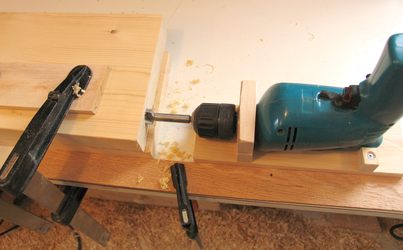
There are times when you have to drill a piece of wood that just won't fit in a drill press - like when drilling holes into the ends of a board. This is where one ideally has something like a horizontal boring machine. When you need one, you need one, but the times are rare enough that most woodworkers don't have one. - unless you own a ShopSmith, which apparently will do a fine job of horizontal boring.
So the few times I needed one, I ended up drilling the holes by hand with a hand drill, but guiding the drill in at exactly the right angle is tricky, and I usually get one of the holes at a bit of an angle by accident, or at least I did when I built this Bed frame

So I came up with this simple horizontal drilling jig, which solves much of the problem.
The jig consists of basically a piece of wood, which is precisely aligned with the
shaft of the drill, and mounted on the top of a hand drill. By placing the drill upside down on a flat surface, with the piece to be drilled clamped
next to it, this allows precise guiding of the drill at the right angle into the wood.
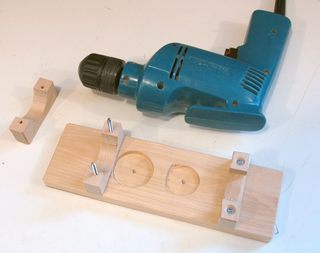
Making such a jig is made a lot easier by the fact that a lot of drills have a cylindrical section just behind the chuck. This makes for a really good primary attachment point for the jig. The two of my hand drills that have this cylindrical part have it with a diameter of 43 millimeters. My forstner bit set has size increments of 1/8" up to 2" in diameter. So for my initial experiment, I picked the 1 3/4" drill for the hole, which is 44.5 millimeters, giving me about 1.5mm of slack, which I figured I could take up by moving the two clamping block halves closer together once I'd cut them.
This turned out not to be ideal, because with this approach, the shaft of the drill primarily clamped the flat parts at the top and bottom of the clamp, so it could be yawed side to side a little bit.
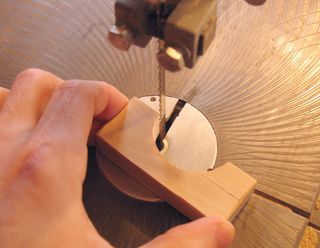 I made a second jig, this time drilling a hole of 1 3/8" diameter (41.3 millimeters),
or about 1.7 millimeters too small. After drilling the hole, and then cutting the block
in half on the table saw, I just needed to open the sides of the hole a little bit
with the band saw. I didn't really need to cut very much off - just graze it repeatedly
with the side of the bandsaw blade (see image at left). I was able to get the drill
to clamp much more rigidly in the block using this approach.
I made a second jig, this time drilling a hole of 1 3/8" diameter (41.3 millimeters),
or about 1.7 millimeters too small. After drilling the hole, and then cutting the block
in half on the table saw, I just needed to open the sides of the hole a little bit
with the band saw. I didn't really need to cut very much off - just graze it repeatedly
with the side of the bandsaw blade (see image at left). I was able to get the drill
to clamp much more rigidly in the block using this approach.
In my version of the jig, I had to drill a few wide and shallow holes in the board to allow for parts of the drill housing to protrude into it. I could have just made a taller block to clamp the drill a little further from the board, but I figured it would be better to have the drill closer to the board.
The improved clamping block still wasn't rigid to my satisfaction, so I added another support block closer to the handle of the drill. I cut this to match the top back corner of the drill, and used it to ensure that the drill would be horizontal. Clamping a long drill into the drill helps for this. A steel rod or shaft would work even better.
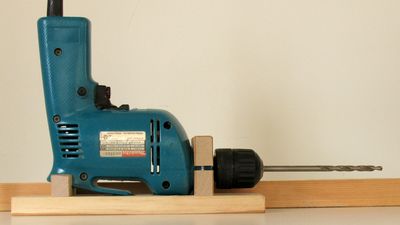
First alignment was to eyeball it with a straight piece of wood behind it (see above), the next alignment was simply to hold a piece of wood against the drill, while sliding it back and forth. This also allowed alignment check in the yaw (side to side) direction, not just up and down.
To use the jig, just clamp a piece of wood to the edge of your workbench as a guide, and then clamp the work piece to the work bench, with another piece of wood underneath to bring it up to the right height. You will have to ensure the board and the guide are both parallel to the edge of your workbench, unless of course you want your holes to be at an angle.
When drilling several holes side by side, to avoid having to re-clamp the work piece, it helps to just put some pieces of wood between the guide piece and the drill jig to move the drill side to side.
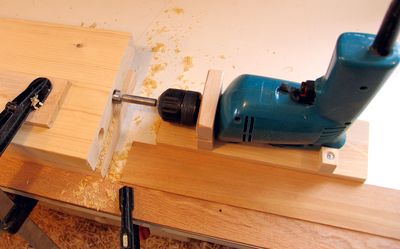
I found this approach to be not quite accurate enough to space holes for dowels though, so it is probably better to mark the hole locations beforehand with an awl, or use some guide piece with holes in it already attached to the end of the piece of wood. But at least, once you have the position of the hole, you won't have to worry about getting it in straight.
As an aside, this drill has a wooden fan blade in it from when I repaired it some years earlier.
If you build your own jig, here's a few more useful tips not mentioned so far:
Update 2019
I never ended up used that jig again after I built it in 2007. The main problem was that it wasn't
stiff enough for what wanted to use it for. But twelve years later, someone sent me this
this square drill which does exactly what my
jig intended to do, but built very solidly.